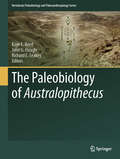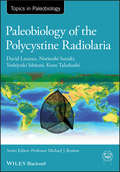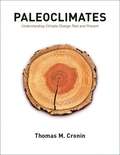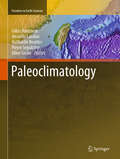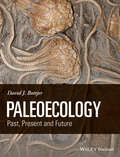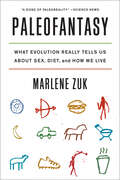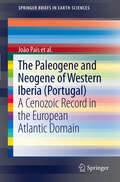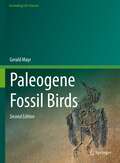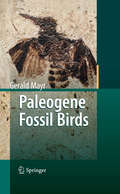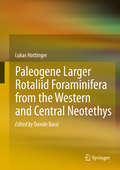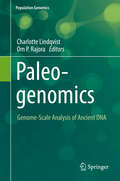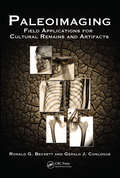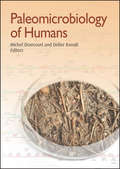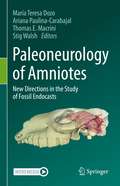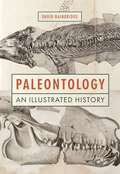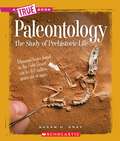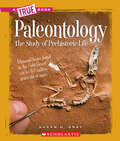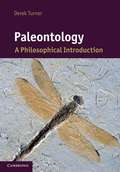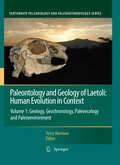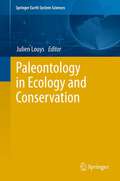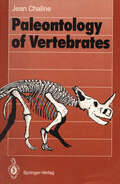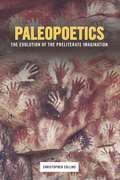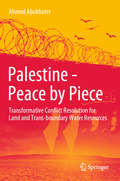- Table View
- List View
The Paleobiology of Australopithecus
by John G. Fleagle Kaye E. Reed Richard E. LeakeyAustralopithecus species have been the topic of much debate in palaeoanthropology since Raymond Dart described the first species, Australopithecus africanus, in 1925. This volume synthesizes the geological and paleontological context of the species in East and South Africa; covers individual sites, such as Dikika, Hadar, Sterkfontein, and Malapa; debates the alpha taxonomy of some of the species; and addresses questions regarding the movements of the species across the continent. Additional chapters discuss the genus in terms of sexual dimorphism, diet reconstruction using microwear and isotopic methodologies, postural and locomotor behavior, and ontogeny.
Paleobiology of the Polycystine Radiolaria (TOPA Topics in Paleobiology)
by Noritoshi Suzuki David Lazarus Yoshiyuki Ishitani Kozo TakahashiPolycystine radiolaria are exclusively marine protists and are found in all ocean waters, from polar regions to the tropics, and at all water depths. There are approximately 600 distinct described living species and several thousand fossil species of polycystines. Radiolarians in general, and polycystines in particular, have recently been shown to be a major component of the living plankton and important to the oceanic carbon cycle. As fossils radiolarians are also fairly common, and often occur in sediments where other types of fossils are absent. This has made them very valuable for certain types of geologic research, particularly estimating the geologic age of the sediments containing them, and as guides to past oceanic water conditions. As our current understanding of the biology, and even taxonomy of the living fauna is still very incomplete, evolutionary studies based on living polycystines are still rare. However, the common occurrence of numerous specimens for many species, and in a wide variety of oceanic environments, provides an excellent opportunity to study the processes of biologic evolution in the fossil record. Paleobiology of the Polycystine Radiolaria is the first major book on radiolarians to appear in the western literature since 2001. Focusing on living and fossil siliceous shelled radiolarians, it is notable for its emphasis not upon morphologic or taxonomic detail but on concepts and applications. The book attempts to provide a balanced, critical review of what is known of the biology, ecology, and fossil record of the group, as well as their use in evolutionary, biostratigraphic and paleoceanographic research. Full chapters on the history of study, and molecular biology, are the first ever in book form. Written for an audience of advanced undergraduate to doctoral students, as well as for a broad range of professionals in the biological and Earth sciences, Paleobiology of the Polycystine Radiolaria summarizes current understanding of the marine planktonic protist group polycystine radiolaria, both in living and fossil form.
Paleoclimates: Understanding Climate Change Past and Present
by Thomas CroninThe field of paleoclimatology relies on physical, chemical, and biological proxies of past climate changes that have been preserved in natural archives such as glacial ice, tree rings, sediments, corals, and speleothems. Paleoclimate archives obtained through field investigations, ocean sediment coring expeditions, ice sheet coring programs, and other projects allow scientists to reconstruct climate change over much of earth's history. When combined with computer model simulations, paleoclimatic reconstructions are used to test hypotheses about the causes of climatic change, such as greenhouse gases, solar variability, earth's orbital variations, and hydrological, oceanic, and tectonic processes. This book is a comprehensive, state-of-the art synthesis of paleoclimate research covering all geological timescales, emphasizing topics that shed light on modern trends in the earth's climate. Thomas M. Cronin discusses recent discoveries about past periods of global warmth, changes in atmospheric greenhouse gas concentrations, abrupt climate and sea-level change, natural temperature variability, and other topics directly relevant to controversies over the causes and impacts of climate change. This text is geared toward advanced undergraduate and graduate students and researchers in geology, geography, biology, glaciology, oceanography, atmospheric sciences, and climate modeling, fields that contribute to paleoclimatology. This volume can also serve as a reference for those requiring a general background on natural climate variability.
Paleoclimatology (Frontiers in Earth Sciences)
by Gilles Ramstein Amaëlle Landais Nathaelle Bouttes Pierre Sepulchre Aline GovinThis two-volume book provides a comprehensive, detailed understanding of paleoclimatology beginning by describing the “proxy data” from which quantitative climate parameters are reconstructed and finally by developing a comprehensive Earth system model able to simulate past climates of the Earth. It compiles contributions from specialists in each field who each have an in-depth knowledge of their particular area of expertise.The first volume is devoted to “Finding, dating and interpreting the evidence”. It describes the different geo-chronological technical methods used in paleoclimatology. Different fields of geosciences such as: stratigraphy, magnetism, dendrochronology, sedimentology, are drawn from and proxy reconstructions from ice sheets, terrestrial (speleothems, lakes, and vegetation) and oceanic data, are used to reconstruct the ancient climates of the Earth. The second volume, entitled “Investigation into ancient climates,” focuses on building comprehensive models of past climate evolution. The chapters are based on understanding the processes driving the evolution of each component of the Earth system (atmosphere, ocean, ice). This volume provides both an analytical understanding of each component using a hierarchy of models (from conceptual to very sophisticated 3D general circulation models) and a synthetic approach incorporating all of these components to explore the evolution of the Earth as a global system.As a whole this book provides the reader with a complete view of data reconstruction and modeling of the climate of the Earth from deep time to present day with even an excursion to include impacts on future climate.
Paleoecology
by David J. BottjerPaleoecology is a discipline that uses evidence from fossils to provide an understanding of ancient environments and the ecological history of life through geological time. This text covers the fundamental approaches that have provided the foundation for present paleoecological understanding, and outlines new research areas in paleoecology for managing future environmental and ecological change. Topics include the use of actualism in paleoecology, development of paleoecological models for paleoenvironmental reconstruction, taphonomy and exceptional fossil preservation, evolutionary paleoecology and ecological change through time, and conservation paleoecology. Data from studies of invertebrates, vertebrates, plants and microfossils, with added emphasis on bioturbation and microbial sedimentary structures, are discussed. Examples from marine and terrestrial environments are covered, with a particular focus on periods of great ecological change, such as the Precambrian-Cambrian transition and intervals of mass extinction. Readership: This book is designed for advanced undergraduates and beginning graduate students in the earth and biological sciences, as well as researchers and applied scientists in a range of related disciplines.
Paleofantasy: What Evolution Really Tells Us About Sex, Diet, And How We Live
by Marlene Zuk“With…evidence from recent genetic and anthropological research, [Zuk] offers a dose of paleoreality.” —Erin Wayman, Science News We evolved to eat berries rather than bagels, to live in mud huts rather than condos, to sprint barefoot rather than play football—or did we? Are our bodies and brains truly at odds with modern life? Although it may seem as though we have barely had time to shed our hunter-gatherer legacy, biologist Marlene Zuk reveals that the story is not so simple. Popular theories about how our ancestors lived—and why we should emulate them—are often based on speculation, not scientific evidence. Armed with a razor-sharp wit and brilliant, eye-opening research, Zuk takes us to the cutting edge of biology to show that evolution can work much faster than was previously realized, meaning that we are not biologically the same as our caveman ancestors. Contrary to what the glossy magazines would have us believe, we do not enjoy potato chips because they crunch just like the insects our forebears snacked on. And women don’t go into shoe-shopping frenzies because their prehistoric foremothers gathered resources for their clans. As Zuk compellingly argues, such beliefs incorrectly assume that we’re stuck—finished evolving—and have been for tens of thousands of years. She draws on fascinating evidence that examines everything from adults’ ability to drink milk to the texture of our ear wax to show that we’ve actually never stopped evolving. Our nostalgic visions of an ideal evolutionary past in which we ate, lived, and reproduced as we were “meant to” fail to recognize that we were never perfectly suited to our environment. Evolution is about change, and every organism is full of trade-offs. From debunking the caveman diet to unraveling gender stereotypes, Zuk delivers an engrossing analysis of widespread paleofantasies and the scientific evidence that undermines them, all the while broadening our understanding of our origins and what they can really tell us about our present and our future.
The Paleogene and Neogene of Western Iberia (Portugal)
by João PaisThis volume includes a general description of the Portuguese Cenozoic basins in the Iberian tectonic context. The main stratigraphic units, including sedimentological, stratigraphical and palaeontological data, are characterized. Correlations between different sectors are presented as well as general paleogeographical evolution maps. The volume includes a general bibliography concerning the Cenozoic of Portugal.
Paleogene Fossil Birds (Fascinating Life Sciences)
by Gerald MayrThis second, completely revised edition of “Paleogene fossil birds” gives a comprehensive, updated overview of the avian fossil record from a geological period that lasted from the end-Cretaceous mass extinction event (66 million years ago) to the end of the Oligocene epoch (23 mya). Paleogene avifaunas are highly diversified and not only feature unusual archaic groups without close living relatives but also offer unique insights into the evolution and biogeographic history of extant birds.The main body of the book constitutes an in-depth survey of the known diversity of Paleogene avifaunas. The reader is introduced into basic skeletal features of extinct avian taxa, with these fossil forms being placed into a phylogenetic context in the light of current hypotheses on the interrelationships of extant birds. The geographical and temporal occurrences of the various fossil groups are outlined and their evolutionary significance is discussed. Concluding sections inform more general aspects of Paleogene avifaunas, such as possible causes of major faunal changes.In addition to being a reference work for the early evolution of modern birds from a paleornithological perspective, the present work also enables researchers in other fields of vertebrate paleontology to gain an improved understanding of Paleogene ecosystems. Numerous color photos of representative specimens furthermore make the new edition attractive to a wider audience interested in the avian fossil record.
Paleogene Fossil Birds
by Gerald MayrThe present book is the first detailed review of the Paleogene avian fossil record on a worldwide scale. Numerous well-preserved fossil bird remains from this geological period, which covers the time span from the end of the Mesozoic era to the beginning of the Miocene, have been described in the past two decades. Some of these not only provide information on morphological transformations in the evolutionary history of the extant avian taxa, but are also of great significance for an understanding of their historical biogeography. Others represent extinct taxa which sometimes show a bizarre morphology not found in modern birds, such as the giant pseudo-toothed birds which reached wingspans up to six meters. The reader is introduced to basic morphological features of the various groups which, as far as possible, are placed into a phylogenetic context in the light of current hypotheses on the interrelationships of extant birds. In a concluding chapter the biogeographical significance of Paleogene fossil birds and possible reasons for faunal changes during the Paleogene are detailed. As such, the book not only aims at providing an overview for specialists, but may also help students of other fields of vertebrate paleontology to better understand Paleogene ecosystems.
Paleogene larger rotaliid foraminifera from the western and central Neotethys
by Lukas Hottingerdavide BassiThis book provides a representative assessment of the state of the art of research on Paleogene rotaliid larger foraminifera. It gives an overview of the current understanding of systematics of this group and, in particular, of its biostratigraphic importance and palaeobiogeography. The senior author of the work, late Professor Hottinger, a leading scientist in the field, both from a systematic and applied side, presents in this book his most recent advances. The foraminiferal family Rotaliidae is a traditional group used frequently which plays an important role for petroleum exploration in the biostratigraphy and palaeobiogeography of Paleogene shallow water deposits in the Middle East. This book aims to introduce rotaliid representatives as index fossils that can be recognized in random thin-sections of cemented rocks. The book is generously illustrated with an unprecedented degree of accuracy. The selection of taxa is restricted to forms having lived in the Paleocene and the Eocene, where their biostratigraphic significance is much higher than during later epochs. However, some additional rotaliid taxa, from the Late Cretaceous or that do not belong to the family Rotaliidae sensu stricto, are included in this book in order to demonstrate particular roots of rotaliid phylogenetic lineages in the previous community maturation cycle or to delimit the taxon Rotaliidae with more precision. This book can be considered as a reference in the field.
Paleogenomics: Genome-Scale Analysis of Ancient DNA (Population Genomics)
by Charlotte Lindqvist Om P. RajoraAdvances in genome-scale DNA sequencing technologies have revolutionized genetic research on ancient organisms, extinct species, and past environments. When it is recoverable after hundreds or thousands of years of unintended preservation, “ancient DNA” (or aDNA) is often highly degraded, necessitating specialized handling and analytical approaches. Paleogenomics defines the field of reconstructing and analyzing the genomes of historic or long-dead organisms, most often through comparison with modern representatives of the same or similar species. The opportunity to isolate and study paleogenomes has radically transformed many fields, spanning biology, anthropology, agriculture, and medicine. Examples include understanding evolutionary relationships of extinct species known only from fossils, the domestication of plants and animals, and the evolution and geographical spread of certain pathogens. This pioneering book presents a snapshot view of the history, current status, and future prospects of paleogenomics, taking a broad viewpoint that covers a range of topics and organisms to provide an up-to-date status of the applications, challenges, and promise of the field. This book is intended for a variety of readerships, including upper-level undergraduate and graduate students, professionals and experts in the field, as well as anyone excited by the extraordinary insights that paleogenomics offers.
Paleoimaging: Field Applications for Cultural Remains and Artifacts
by Ronald G. Beckett Gerald J. ConlogueMedical and industrial imaging methods have come to be recognized as powerful tools for documentation and data collection in many nontraditional settings. In Paleoimaging: Field Applications for Cultural Remains and Artifacts, two of the most preeminent experts in the field provide an in-depth examination of a range of imaging techniques and explain how these techniques can be applied to all aspects of forensic and archaeological analysis.The first part of the book examines paleoimaging multimodalities, highlighting the advantages and disadvantages of each imaging technique in different scenarios. The authors explore photography, conventional radiography, endoscopy, and various forms of computer-based imaging. Next, they present methodological and procedural standards for the various imaging techniques. They also demonstrate how multimodal imaging can assist nondestructive data collection of non-biological cultural artefacts. A final section addresses radiation safety and field safety concerns. Case studies, tables, and templates of forms for documentation of findings enhance the text with practical information.Filled with over 380 images, this book is supplemented with an accompanying downloadable resource in which the authors draw from their global experience in the paleoimaging of cultural remains and artefacts, offering a view of the diverse environments in which field paleoimaging is conducted. The breadth of the authors’ expertise and the rich images contained in the book and downloadable resources make this resource an essential reference for those who seek to explore the mysteries of the past.
Paleomicrobiology of Humans (ASM Books)
by Michel Drancourt Didier A. RaoultOnly recently was it determined that two of the world's most devastating plagues, the plague of Justinian and the medieval Black Death, were caused by distinct strains of the same pathogen. Use of paleomicrobiological techniques led to this discovery. This work is just one example of the historical mysteries that this emerging field has helped to clarify. Others, such as when tuberculosis began to afflict humans, the role of lice in plague pandemics, and the history of smallpox, are explored and further illuminated in Paleomicrobiology of Humans. Led by editors Michel Drancourt and Didier Raoult, the book's expert contributors address larger issues using paleomicrobiology. These include the recognition of human remains associated with epidemic outbreaks, identification of the graves of disasters, and the discovery of demographic structures that reveal the presence of an epidemic moment. In addition, the book reviews the technical approaches and controversies associated with recovering and sequencing very old DNA and surveys modern human diseases that have ancient roots. Essentially, paleomicrobiologists aim to identify past epidemics at the crossroads of different specialties, including anthropology, medicine, molecular biology, and microbiology. Thus, this book is of great interest not only to microbiologists but to medical historians and anthropologists as well. Paleomicrobiology of Humans is the first comprehensive book to examine so many aspects of this new, multidisciplinary, scientific field.
Paleoneurology of Amniotes: New Directions in the Study of Fossil Endocasts
by María Teresa Dozo Ariana Paulina-Carabajal Thomas E. Macrini Stig WalshThis book presents a detailed examination of the current state of knowledge in the field of paleoneurology in the main amniote groups (reptiles, birds and mammals), and advances resulting from new non-invasive technologies. The study of fossil endocasts is an area of considerable current interest, and has long been central to our understanding of the evolution of the brain, development of senses and behavioral adaptations in diverse vertebrate groups and across vertebrates as a whole. Recent advances in non-invasive imaging have significantly increased the number of fossil taxa for which brain morphology is known, and it may now be possible to quantitatively analyze the relative size of brain regions. Providing a general overview of current perspectives and problems in evolutionary neuroanatomy, this book is intended for a wide range of readers, including undergraduate and graduate students, teachers, and anyone with a special interest in paleoneurology. It is also useful as supplementary reading for courses in digital anatomy, vertebrate comparative anatomy, computed morphometrics, paleontology, neurology and radiology as well as evolution programs
La paleontología en 100 preguntas (100 Preguntas esenciales)
by Adriana OliverLas respuestas de la ciencia a las preguntas fundamentales sobre el origen de la vida y el origen del ser humano. Desde las primeras bacterias -3.800 millones de años- y los primeros organismos, plantas y vertebrados, hasta la conquista de la tierra, la era de los dinosaurios, los mamíferos y la aparición de los homínidos en el mioceno hace 7 millones de años. ¿Son primas las ballenas y las vacas?, ¿Cómo eran las primeras formas de vida?, ¿Cómo afectaron los cambios climáticos a la vida?, ¿Cómo pudo surgir la primera célula?, ¿Qué es la explosión cámbrica?, ¿Por qué salieron los anfibios del agua?, ¿Es cierto que los dinosaurios tenían miedo a los ratones?, ¿Cómo perdieron las ballenas las patas traseras?, ¿Estamos llegando a la 6º extinción?, ¿Cuáles fueron los primeros europeos?, ¿Cuándo apareció el lenguaje?, ¿Existen fósiles vivientes? ¿Quién no se ha preguntado alguna vez por la aparición de los primeros seres vivos, los dinosaurios que habitaban la Tierra o el origen del ser humano? La paleontología, a través del estudio de los fósiles nos propone un emocionante viaje para conocer los seres vivos que habitaron la Tierra en las diferentes eras geológicas. En este libro te invitamos a bucear entre la historia de la vida en la Tierra y descubrir sus grandes momentos como la aparición de las primeras bacterias hace 3.800 millones de años, pasando por los primeros organismos acorazados, las primeras plantas terrestres, los primeros vertebrados, la conquista de la tierra, los primeros bosques, la era de los dinosaurios, la aparición de los mamíferos, la aparición de las plantas con flor o la aparición de los homínidos. ¿Te animas a descubrir cómo eran?
Paleontological Collections of Germany, Austria and Switzerland: The History of Life of Fossil Organisms at Museums and Universities (Natural History Collections)
by Lothar A. Beck Ulrich JogerThis book is devoted to 250 years of collecting, organizing and preserving paleontological specimens by generations of scientists. Paleontological collections are a huge resource for modern research and should be available for national and international scientists and institutions, as well as prospective public and private customers. These collections are an important part of the scientific enterprise, supporting research, public education, and the documentation of past biodiversity. Much of what we are beginning to understand about our world, we owe to the collection, preservation, and ongoing study of natural specimens. Properly preserved collections of fossil marine or terrestrial plants and animals are archives of Earth's history and vital to our ability to learn about our place in its future.The approach employed by the editors involves not only an introduction to the paleontological collections in general, but also information on the international and national collection networks. Particular attention is given to new exhibition concepts and approaches of sorting, preserving and researching in paleontological collections and also their neglect and/or threat. In addition, the book provides information on all big public museums, on important state museums and regional Museums, and also on university collections.This is a highly informative and carefully presented book, providing scientific insight for readers with an interest in fossil record, biodiversity, taxonomy, or evolution, as well as natural history collections at large.
Paleontology: An Illustrated History
by David BainbridgeAn illustrated look at the art and science of paleontology from its origins to todayHumans have been stumbling upon the petrified remains of ancient animals since prehistoric times, leading to tales of giant dogs, deadly dragons, tree gods, sea serpents, and all manner of strange and marvelous creatures. In this richly illustrated book, David Bainbridge recounts how legends like these gradually gave rise to the modern science of paleontology, and how this pioneering discipline has reshaped our view of the natural world.Bainbridge takes readers from ancient Greece to the eighteenth century, when paleontology began to coalesce into the scientific field we know today, and discusses how contemporary paleontologists use cutting-edge technologies to flesh out the discoveries of past and present. He brings to life the stories and people behind some of the greatest fossil finds of all time, and explains how paleontology has long straddled the spheres of science and art. Bainbridge also looks to the future of the discipline, discussing how the rapid recovery of DNA and other genetic material from the fossil record promises to revolutionize our understanding of the origins and evolution of ancient life.This panoramic book brings together stunning illustrations ranging from early sketches and engravings to eye-popping paleoart and high-tech computer reconstructions.
Paleontology: The Study of Prehistoric Life (True Books)
by Susan H. GrayWhether you're interested in weather, oceans, or even the prehistoric world, earth science covers it all. The fascinating facts and fun activities in these titles help the budding earth scientist in you explore the fields of geology, meteorology, ecology, and more.
Paleontology: The Study of Prehistoric Life (A True Book (Relaunch))
by Susan H. GrayDiscover how paleontologists dig deep to discover these remains and how they use them to learn more about the plants and animals that once covered the planet.A True Book: Earth Science series presents fascinating facts and fun activities that will engage the budding earth scientist, while exploring the fields of geology, meteorology, ecology, and more. This series includes an age appropriate (grades 3-5) introduction to curriculum-relevant subjects and a robust resource section that encourages independent study.Millions of years ago, Earth was populated by animals unlike any that we know today. The only way to learn anything about these extinct species is to study the remains they have left behind in Earth's rocks and soil.
Paleontology
by Derek TurnerIn the wake of the paleobiological revolution of the 1970s and 1980s, paleontologists continue to investigate far-reaching questions about how evolution works. Many of those questions have a philosophical dimension. How is macroevolution related to evolutionary changes within populations? Is evolutionary history contingent? How much can we know about the causes of evolutionary trends? How do paleontologists read the patterns in the fossil record to learn about the underlying evolutionary processes? Derek Turner explores these and other questions, introducing the reader to exciting recent work in the philosophy of paleontology and to theoretical issues including punctuated equilibria and species selection. He also critically examines some of the major accomplishments and arguments of paleontologists of the last 40 years.
Paleontology and Geology of Laetoli: Human Evolution in Context
by Terry HarrisonThis volume 2 and its companion volume 1 present the results of new investigations into the geology, paleontology and paleoecology of the early hominin site of Laetoli in northern Tanzania. The site is one of the most important paleontological and paleoanthropological sites in Africa, worldrenowned for the discovery of fossils of the early hominin Australopithecus afarensis, as well as remarkable trails of its footprints. The first volume provides new evidence on the geology, geochronology, ecology, ecomorphology and taphonomy of the site. The second volume describes newly discovered fossil hominins from Laetoli, belonging to Australopithecus afarensis and Paranthropus aethiopicus, and presents detailed information on the systematics and paleobiology of the diverse associated fauna. Together, these contributions provide one of the most comprehensive accounts of a fossil hominin site, and they offer important new insights into the early stages of human evolution and its context.
Paleontology in Ecology and Conservation
by Julien LouysThe fossil record contains unique long-term insights into how ecosystems form and function which cannot be determined simply by examining modern systems. It also provides a record of endangered species through time, which allow us to make conservation decisions based on thousands to millions of years of information. The aim of this book is to demonstrate how palaeontological data has been or could be incorporated into ecological or conservation scientific studies. This book will be written by palaeontologists for modern ecologists and conservation scientists. Manuscripts will fall into one (or a combination) of four broad categories: case studies, review articles, practical considerations and future directions. This book will serve as both a 'how to guide' and provide the current state of knowledge for this type of research. It will highlight the unique and critical insights that can be gained by the inclusion of palaeontological data into modern ecological or conservation studies.
Paleontology of Vertebrates
by Jean ChalinePaleontology of Vertebrates is an introductory text for students in Earth Sciences. It offers the basic knowledge and describes the evolution of vertebrate groups, successfully applying the cladistic approach. The reader will learn how vertebrate paleontology can contribute to solve problems in various fields of geosciences, such as biostratigraphy, paleoenvironmental reconstructions and geophysical modes.
Paleopoetics: The Evolution of the Preliterate Imagination
by Christopher CollinsChristopher Collins introduces an exciting new field of research traversing evolutionary biology, anthropology, archaeology, cognitive psychology, linguistics, neuroscience, and literary study. Paleopoetics maps the selective processes that originally shaped the human genus millions of years ago and prepared the human brain to play, imagine, empathize, and engage in fictive thought as mediated by language. A manifestation of the "cognitive turn" in the humanities, Paleopoetics calls for a broader, more integrated interpretation of the reading experience, one that restores our connection to the ancient methods of thought production still resonating within us.Speaking with authority on the scientific aspects of cognitive poetics, Collins proposes reading literature using cognitive skills that predate language and writing. These include the brain's capacity to perceive the visible world, store its images, and retrieve them later to form simulated mental events. Long before humans could share stories through speech, they perceived, remembered, and imagined their own inner narratives. Drawing on a wide range of evidence, Collins builds an evolutionary bridge between humans' development of sensorimotor skills and their achievement of linguistic cognition, bringing current scientific perspective to such issues as the structure of narrative, the distinction between metaphor and metonymy, the relation of rhetoric to poetics, the relevance of performance theory to reading, the difference between orality and writing, and the nature of play and imagination.
Palestine - Peace by Piece: Transformative Conflict Resolution for Land and Trans-boundary Water Resources
by Ahmed AbukhaterThis book draws lessons and conclusions, based on the methodology outlined in the author's previous book, Water as a Catalyst for Peace (Routledge, 2013), and further charts the course to a more practical framework for achieving regional stability and justice. Past agreements are examined and analysed, outlining the change along the way that occurred to the land and people of Palestine. The book is written with the intention of exposing past events that led to the current situation, evaluating the current state of the conflict in light of new circumstances and the reality on the ground. Viable options are explored to seek a practical and satisfactory negotiated settlement that ensures justice and viability. In conclusion, a roadmap for future direction is proposed to achieve equitable water allocation through proper negotiation between Israel and Palestine and to ultimately settle the conflict. Water resources allocation is at the heart of this pragmatic framework and roadmap.
